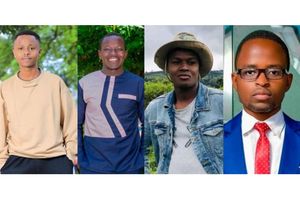THE SOJOURNER: Remembering Nelson Mandela’s walk to freedom that February

Nelson Mandela gestures after he was released from prison almost three decades ago. PHOTO|FILE
Much as I look young I am basically a typical ‘Mhenga’. Actually I have been around for long. Naturally a lot of water has passed under this bridge. But two major ‘tsunamis’ stand out. And they were indeed seismic events.
One: the famous walk by President Barak Obama and his wife Michelle along Pennsylvania Ave, on 20 January 1999, during his inauguration parade as the 44th president of the United States - the first African-American to that post.
Second: the famous Nelson Mandela walk out the front gate of the Victor Verster Prison in suburban Cape Town on the sun-splashed afternoon of Feb. 11, 1990, arm-in-arm with his then-wife, Winnie. Each raised a fist in triumph.
The latter event was what came to mind last Sunday since it was exactly 28 years from that famous afternoon walk - the walk to freedom! After 27 years in prison.
No wonder the first thing I did when one morning I first landed at the O. R. Tambo Airport in Johannesburg – 10 years after that walk - and after dropping my bags at my hotel, I took a taxi to House No. 9115, Vilakazi Street, Orlando West, Soweto, to visit the famous Mandela House.
But that is a story for another day. Back to the famous walk..... The evening before his release from prison, Mandela was ushered into a secret meeting with South African President F.W. de Klerk for a conversation that sounded straight from the theatre of the absurd.
De Klerk told Mandela he would be a free man the next day, making good on a pledge the president had made a week earlier, though without setting the exact date. Yet Mandela was still caught off guard.
“I deeply wanted to leave prison as soon as I could, but to do so on such short notice would not be wise,” Mandela wrote later in his autobiography, Long Walk To Freedom. “I thanked Mr. de Klerk, and then said that at the risk of appearing ungrateful I would prefer to have a week’s notice in order that my family and my organisation could be prepared.”
Taken aback, de Klerk excused himself to consult with his advisers. Several minutes later, he returned and insisted that Mandela, like a house guest who had hung around too long, would have to check out the next day whether he liked it or not. Mandela relented, and the jailer and the jailed shared a glass of whiskey.
Greg Myre writes in The Parallels of the anxiety during that time. Nobody knew what would happen next. Mandela had disappeared from view in 1964 after giving a four-hour speech at the conclusion of his sabotage trial, where he was convicted and received a life sentence.
As the ‘freedom convoy’ drove into the city, “People began knocking on the windows, and then on the [trunk and the hood],” Mandela wrote. “Inside it sounded like a massive hailstorm. Then people began jumping on the car in their excitement. Others began to shake it and at that moment I began to worry. I felt as though the crowd might very well kill us with their love.”
Rather than continue into the crowd, Mandela diverted the driver to the nearby home of Dullah Omar, one of Mandela’s lawyers. Omar was stunned to find Mandela at his front door. “Aren’t you meant to be at the Grand Parade?” he asked.
Mandela went in for a cold drink at Omar’s home. Soon Archbishop Desmond Tutu called in great distress and urged him to return.
Mandela got back in the car, the mobbing continued as he approached City Hall. He eventually arrived at twilight, facing a sea of frenzied supporters from the balcony. He took out his prepared remarks ... and realised he had left his reading glasses at the prison. So he borrowed Winnie’s.
“Comrades and fellow South Africans, I greet you all in the name of peace, democracy and freedom,” said Mandela. “I stand here before you not as a prophet, but as a humble servant of you the people. ...” And the rest as they say is history.



